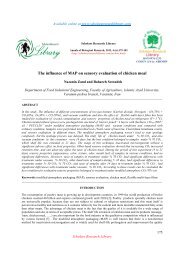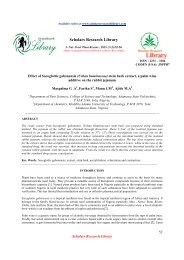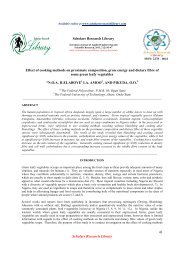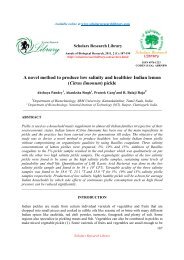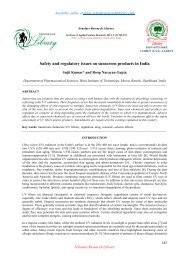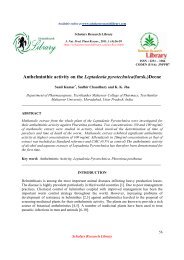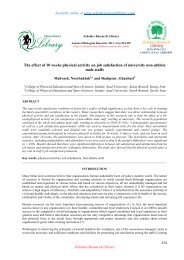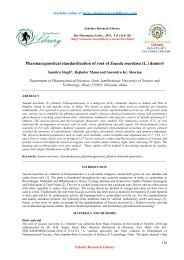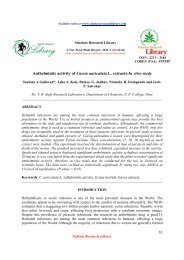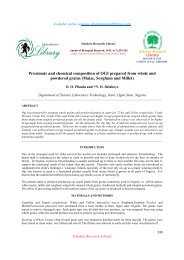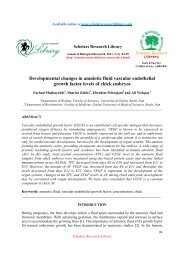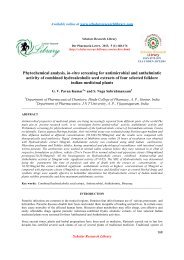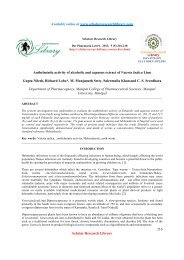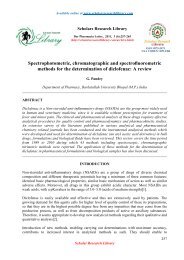A review: Natural products from plant associated endophytic fungi
A review: Natural products from plant associated endophytic fungi
A review: Natural products from plant associated endophytic fungi
Create successful ePaper yourself
Turn your PDF publications into a flip-book with our unique Google optimized e-Paper software.
Journal of Microbiology and Biotechnology Research<br />
Scholars Research Library<br />
J. Microbiol. Biotech. Res., 2011, 1 (2): 21-32<br />
(http://scholarsresearchlibrary.com/archive.html)<br />
ISSN : 2231 –3168<br />
CODEN (USA) : JMBRB4<br />
A <strong>review</strong>: <strong>Natural</strong> <strong>products</strong> <strong>from</strong> <strong>plant</strong> <strong>associated</strong> <strong>endophytic</strong> <strong>fungi</strong><br />
Ruby Erach Jalgaonwala* 1 , Bhavna Vishwas Mohite 2 , Raghunath Totaram Mahajan 2<br />
1, 2 Department of Biotechnology Moolji Jaitha College Jalgaon M.S.India<br />
______________________________________________________________________________<br />
ABSTRACT<br />
This <strong>review</strong> describes information on the role of <strong>endophytic</strong> microorganisms and some of<br />
naturally occurring bioactive compounds obtained <strong>from</strong> <strong>endophytic</strong> <strong>fungi</strong> isolated <strong>from</strong> various<br />
host <strong>plant</strong>s. In the recent past years, a great deal of information on the role of endophytes in<br />
nature has been collected. The main topics addressed are isolation of endophytes, host<br />
endophyte relationship, fungal endophyte, their diversity, physiological role of endophyte,<br />
biological activities and chemistry.<br />
Key words: Endophytic microorganisms, biological activity, endophyte diversity, antioxidation<br />
activity.<br />
______________________________________________________________________________<br />
INTRODUCTION<br />
Endophytes are those microorganisms that inhabit interior of <strong>plant</strong>s especially leaves, stems,<br />
roots shows no apparent harm to host [1]. Almost all classes of vascular <strong>plant</strong>s and grasses<br />
examined to date are found to host <strong>endophytic</strong> organisms [2]. Different groups of organisms such<br />
as <strong>fungi</strong>, bacteria, actinomycetes and mycoplasma are reported as endophytes of <strong>plant</strong>s [3]. The<br />
existence of endophytes has been known for over one hundred years. In literal translation, the<br />
word endophyte is derived <strong>from</strong> Greek, ‘endo’ >< ‘endon’ meaning within, and ‘phyte’><<br />
‘phyton’ meaning <strong>plant</strong>. Research of <strong>endophytic</strong> <strong>fungi</strong> has a long history and their diversity<br />
among <strong>plant</strong>s has been found to be considerably large. Each <strong>plant</strong> has been reported to harbor<br />
one or more endophytes [4, 5] (Figure 1). Recently endophytes are viewed as outstanding source<br />
of secondary metabolites bioactive antimicrobial natural <strong>products</strong>. These microorganisms<br />
received considerable attention in last 20 years when their capacity to protect against insect and<br />
pest pathogens was noticed [1]. Botanists have carried out much research into the <strong>plant</strong><br />
Scholar Research Library<br />
21
Ruby Erach Jalgaonwala et al J. Microbiol. Biotech. Res., 2011, 1 (2):21-32<br />
______________________________________________________________________________<br />
endophyte relation. The aim of this <strong>review</strong> is to provide recent data about fungal endophytes and<br />
their bioprospecting.<br />
Figure 1. Endophytes asexual life Cycle<br />
Host endophyte relationship<br />
Recent studies shows that endophytes are not host specific [6]. Single endophytes can invage a<br />
wide host range. Studies suggest that some strains of the same fungus isolated <strong>from</strong> different<br />
parts of the same host differ in their ability to utilize different substances [7]. So endophytes can<br />
be isolated <strong>from</strong> different <strong>plant</strong>s belongs to the different families and classes and grow under<br />
different ecological and geographical conditions [8]. Host endophyte relationship may be<br />
variable <strong>from</strong> host to host and endophyte. Some research showed that host <strong>plant</strong> and endophyte<br />
relationship are able to balanced pathogen host antagonism not truly symbiotic one [9] (Figure 2)<br />
Plant endophyte interactions affect metabolite production<br />
In 2008 Moricca and Ragazzi [10] showed that the type of interaction between an endophyte and<br />
a <strong>plant</strong> is controlled by the genes of both organisms and modulated by the environment. The<br />
endophyte may present in a metabolically hostile environment and continuously encountering<br />
host defense chemicals [9]. Endophytic <strong>fungi</strong> <strong>from</strong> medicinal <strong>plant</strong>s could be a rich source of<br />
functional metabolites [11-15]. Endophyte <strong>plant</strong> association could be could also be subjugated to<br />
stimulate the production of secondary metabolites by host <strong>plant</strong>. Plants growing in adverse<br />
habitats have to be screened for isolation of endophytes and their metabolites [16,17].The<br />
observation by Baily [18], indicates that endophyte infections alters pattern of gene expression<br />
Scholar Research Library<br />
22
Ruby Erach Jalgaonwala et al J. Microbiol. Biotech. Res., 2011, 1 (2):21-32<br />
______________________________________________________________________________<br />
in the host <strong>plant</strong>. Endophytes <strong>from</strong> angiosperms and gymnosperms have been studied for novel<br />
secondary metabolites. Suryanarayanan, Zhang and Li emphasis on evaluation of endophytes in<br />
lower <strong>plant</strong>s namely algae, bryophytes, pteridophytes and lichens in addition with higher <strong>plant</strong>s<br />
[19-21].<br />
+ Fungal Benefit +<br />
E<br />
n<br />
d<br />
o<br />
p<br />
h<br />
y<br />
t<br />
Figure 2. Host endophyte relationship<br />
i<br />
s<br />
m<br />
- Fungal harm -<br />
Physiological role of <strong>endophytic</strong> <strong>fungi</strong><br />
Endophytic <strong>fungi</strong> are reported <strong>from</strong> <strong>plant</strong>s occurred in various environment conditions including<br />
tropic [22], temperate [23], Xerophytic [19] and aquatic [24]. Current studies have shown that<br />
tall fescue toxicosis is mediated by a number of compounds including clavinet alkaloids, lysegic<br />
acid amides and ergopeptines [25].<br />
Protection <strong>from</strong> pathogens<br />
Endophytic <strong>fungi</strong> are known to be a rich source of novel antimicrobial substances. The<br />
endophyte <strong>associated</strong> <strong>plant</strong>s produces some metabolites that induces resistance. It was found that<br />
symbiotic <strong>plant</strong> activates defense system more quickly than non symbiotic <strong>plant</strong>s after pathogen<br />
challenge.<br />
Role of endophytes in abiotic stress tolerance<br />
Researchers have shown that some <strong>endophytic</strong> <strong>fungi</strong> are able to protect their host <strong>plant</strong> <strong>from</strong><br />
Scholar Research Library<br />
23
Ruby Erach Jalgaonwala et al J. Microbiol. Biotech. Res., 2011, 1 (2):21-32<br />
______________________________________________________________________________<br />
drought conditions [26]. Also salt tolerance is observed in <strong>plant</strong>s infected with endophytes [27].<br />
Endophytic <strong>fungi</strong> also increase heat tolerance in their host. So it can be said that endophytes acts<br />
as biological trigger to activate the stress response more rapidly and strongly than non symbiotic<br />
<strong>plant</strong>s [28].<br />
Fungal endophyte diversity<br />
Endophytic fungal symbionts can have profound effects on <strong>plant</strong> ecology, fitness and evolution.<br />
Diverse group of this organism are able to produce number of bioactive agents [29-31]. The<br />
fossil record indicates that <strong>plant</strong> have been <strong>associated</strong> with <strong>endophytic</strong> <strong>fungi</strong>, for >400 Myr and<br />
were likely <strong>associated</strong> when <strong>plant</strong>s colonized land, thus having an important role in driving the<br />
evolution of life on land [32]. Clavicipitaceous endophytes are Class I endophytes represents a<br />
small number of phylogenetically related Clavicipitaceous species that are fastidious in culture<br />
and limited to some cool and warm season grasses[33-34]. Transmission of class I endophytes is<br />
primarily vertical, with maternal <strong>plant</strong>s passing <strong>fungi</strong> on to offspring via seed infections [35].<br />
The benefits conferred by these <strong>fungi</strong> appear to depend on the host species, host genotype and<br />
environmental conditions [36]. Diversity of class 2 endophytes in individual host <strong>plant</strong>s is quite<br />
limited. Class 2 endophyte comprises a diversity of species, all of which are members of the<br />
Dikarya (Ascomycota or Basidiomycota). They have ability to confer habitat specific stress<br />
tolerance to host <strong>plant</strong>s [37]. Researchers proposed that Clavicipitaceous endophytes are<br />
defensive mutualists of host grasses and this hypothesis gets widely accepted on endophytes<br />
natural history, evolution, ecology and physiology and followed by number of researchers [38-<br />
45]. Class 3 endophytes are distinguished on the basis of their occurrence and horizontal<br />
transmission. This includes vascular, nonvascular <strong>plant</strong>s, woody and herbaceous angiosperms in<br />
tropical forest and antarctic communities [46-49]. Class 3 endophytes are especially known for<br />
their great diversity within individual host tissues, <strong>plant</strong>s and populations. Individual leaves may<br />
harbor up to one isolate per 2mm 2 of leaf tissue and contains number of species. Single <strong>plant</strong> may<br />
harbor hundreds of different <strong>endophytic</strong> <strong>fungi</strong>. Class 4 endophytes have darkly melanized septa<br />
and restricted to <strong>plant</strong> roots. They are generally Ascomycetous <strong>fungi</strong> which are conidial or sterile<br />
and that form melanized structures like inter and intracellular hyphae and microsclerotia in the<br />
roots. This class of endophytes found in host <strong>plant</strong>s like nonmycorrhizal <strong>from</strong> antarctic, arctic,<br />
alpine, sub-alpine, temperate zones and tropical ecosystems [50].<br />
Methods for isolation of endophytes<br />
A number of methods for isolation of endophytes are described in literatures. A convenient and<br />
common method accepted by many researchers is to dip the tissues in 70% alcohol for few<br />
seconds or in 0.5-3.5% sodium hypochlorite for 1-2 minutes followed by rinses in sterile double<br />
distilled water before plating it on a nutrient medium for isolation of <strong>endophytic</strong> microorganisms<br />
[29]. Some Isolates require months or more time in culture before they sporulate. Even stop<br />
sporulating after they have been transferred several times. For isolation of fungal endophytes<br />
surface sterilization of tissue requires 70% ethanol for 1-3 minutes, aqueous sodium<br />
hypochloride (4% available chlorine) for 3-5 minutes again rinse with 70% ethanol 2-10 seconds<br />
and final rinse with double distilled water and drying in Laminar air flow [4] also addition of<br />
50mg/l chloramphenicol can be done to suppress bacterial growth [5]. Sterile knife blade is<br />
required to remove outer tissues <strong>from</strong> sample and to excise inner tissues[30].Water agar, Potato<br />
dextrose agar, Yeast extract agar, Rose bengal chloramphenicol agar, Luria bertani agar, Humic<br />
Scholar Research Library<br />
24
Ruby Erach Jalgaonwala et al J. Microbiol. Biotech. Res., 2011, 1 (2):21-32<br />
______________________________________________________________________________<br />
acid vitamin agar are found to be suitable media for isolation of <strong>endophytic</strong> <strong>fungi</strong>, bacteria and<br />
actinomycetes respectively. Temperature of about 25-30 o C is suitable for their growth.<br />
<strong>Natural</strong> <strong>products</strong> <strong>from</strong> endophytes<br />
Anticancer by endophytes<br />
Taxol is the world’s first billion dollar anticancer drug. In addition it is worthy of note that some<br />
<strong>plant</strong>s generating bioactive natural <strong>products</strong> have <strong>associated</strong> endophytes that produce the same<br />
natural <strong>products</strong> (Figure 3). Such is the case with taxol, a highly functionalized diterpenoid and<br />
famed anticancer agent that is found in each of the world’s yew tree species (Taxus sp) [51]. In<br />
1993, a novel taxol producing fungus Taxomyces andreanae, <strong>from</strong> the yew Taxus brevifolia was<br />
isolated and characterized and biodiversity of some <strong>endophytic</strong> <strong>fungi</strong> <strong>from</strong> 29 traditional<br />
Chinese medicinal <strong>plant</strong>s were studied [52,53].Naphthoquinone Spiroketal isolated <strong>from</strong><br />
<strong>endophytic</strong> fungus Edenia gomezpompae .Six new tetramic acids derivatives Penicillenols<br />
A1,A2,B1,B2,C1,C2 [54] together with citrinin, phenol A acid, phenol A and dihydrocitrinin<br />
were identified <strong>from</strong> Penicillium sp an <strong>endophytic</strong> fungus <strong>associated</strong> with Aegiceras<br />
corniculatum. All the new compounds were evaluated for their cytotoxic effects in four cell lines<br />
by the MTT bioassay Penicillenols A. Endophytic fungus Penicillium sp JP-1 isolated <strong>from</strong><br />
Aegiceras corniculatum showed four polketides, leptusphaerone [55] Penicillenone, 9-demethyl<br />
FR-901235 [14] leptosphaerone C showed cytotoxicity against A-549 cells with an Ic 50 Value<br />
of 1.45 um, while penicillenone showed cytotoxicity against P388 cells with an Ic 50 value of<br />
1.58um and arugosin I [13, 14].<br />
Figure 3.Taxol<br />
Antioxidant compounds produced by endophytes<br />
Antioxidant metabolites are often produced by <strong>endophytic</strong> <strong>fungi</strong>. Pestacin (Figure 6) and<br />
Isopestacin (Figure 5) were isolated <strong>from</strong> Pestalotiopsis microspora <strong>from</strong> <strong>plant</strong> Terminalia<br />
morobensis, native of the Papua New Guinea [56].<br />
Endophytes and their antimicrobial activity<br />
Endophytic <strong>fungi</strong> Aspergillus clavatonanicus isolated <strong>from</strong> Torreya mairei produce clavatol<br />
[40]. Endophytic fungus Phomopsis sp YM 311483 produced four new ten membered lactones.<br />
This lactones shows antifungal activity against Aspergillus niger, Botrytis cinere, and<br />
Fusarium[14] were isolated <strong>from</strong> the extract of <strong>endophytic</strong> fungus Xylaria sp PSU-D14<br />
Scholar Research Library<br />
25
Ruby Erach Jalgaonwala et al J. Microbiol. Biotech. Res., 2011, 1 (2):21-32<br />
______________________________________________________________________________<br />
exhibiting two compounds Sordaricin [57] (Figure 7) and 2, 3-dihydro-5 hydroxy-2 methyl-4H-<br />
1-banzopyron-4-1,venaceum Penicillium islandicum and Ophiostoma minus. The glucoside<br />
derivatives, Xularosides A [56]. Endophytic Fusarium Sp <strong>from</strong> <strong>plant</strong> Selaginella pollescens<br />
collected in the Guanacaste conservation area of Costa Rica was screened for antifungal activity<br />
shows potent activity against Candida albicans in agar diffusion assay [30]. Jesterone antifungal<br />
compound which was isolated <strong>from</strong> fungus Pestalotiopsis jesteri. Jesterone is only compound<br />
<strong>from</strong> the endophytes in which total synthesis was reported [58].The <strong>endophytic</strong> fungus<br />
Chloridium sp produces Javanicin [4]. This highly functionalized napthaquinone exhibits strong<br />
antibacterial activity against Pseudomonas sp.Three metabolites Phomoenamide [13],<br />
Phomonitroester and Deacetylphomoxanthone B have been reported <strong>from</strong> <strong>endophytic</strong> fungus<br />
Phomopsis sp PSU D [15]. Patulin is a mycotoxin found to be produced by some of <strong>endophytic</strong><br />
<strong>fungi</strong> (Figure 4).<br />
Figure 4. Patulin<br />
Figure 5. Isopestacin<br />
Figure 6. Pestacin<br />
Scholar Research Library<br />
26
Ruby Erach Jalgaonwala et al J. Microbiol. Biotech. Res., 2011, 1 (2):21-32<br />
______________________________________________________________________________<br />
Figure 7. Sordarcin derivative<br />
Endophytes and some antiviral compounds<br />
Many antiviral agents are reported <strong>from</strong> <strong>endophytic</strong> <strong>fungi</strong>. Two novel compounds cytonic acid A<br />
and B have been isolated <strong>from</strong> the <strong>endophytic</strong> fungus Cytonaema sp. These compounds are<br />
inhibitor of human cytomegalovirus (hCMV) protease [59].<br />
Other natural <strong>products</strong> by endophytes<br />
Gignardic acid was detected in the culture broth of an <strong>endophytic</strong> Gignardia sp. obtained <strong>from</strong><br />
Spondias mombin [60] (Figure 8). The oxidative deamination <strong>products</strong> of L – valine and L –<br />
phenylalanine are biogenetic precursors of this metabolite. A novel compound <strong>from</strong> a Phomopsis<br />
sp <strong>endophytic</strong> in Adenocarpus foliolosus was isolated and identified as phomosine G [61].<br />
Several endophytes are known to have antiinsect properties, nodulisporic acid a novel diterpenes<br />
that exhibits potent insecticidal properties against the larvae of the blowfly. The first<br />
nodulisporium compound was isolated <strong>from</strong> endophytes Nodulispotium sp and Bontia<br />
Daphnoides [4]. Ergot alkaloids consist of different kinds of alkaloids and include ergovaline,<br />
ergotamine, ergosine, ergostine and ergonine. Environmental conditions such as soil temperature<br />
and humidity also are expected to affect the nature and the population of endophytes<br />
Nematicidal/insecticidal metabolites <strong>from</strong> <strong>endophytic</strong> <strong>fungi</strong> Geotrichum sp AL4, isolated <strong>from</strong><br />
leaves of A. indica chlorinated, empimeric compound 1, 3 oxazinane derivatives isolated and<br />
assessed for their nematicidal activity against nematodes. Bursaphelenchus xylophilus and<br />
Panagrellus redivivus showed good bioactivity [62]. Graphislactone A, Botralin and Ulocladol<br />
are acetylcholinesterase (Ach E) inhibitors, isolated <strong>from</strong> an <strong>endophytic</strong> Microsphaeropsis<br />
olivacea, originally obtained <strong>from</strong> Pilgerodendron uviferum a gymnosperm [63]<br />
Figure 8.Gignardic acid<br />
Scholar Research Library<br />
27
Ruby Erach Jalgaonwala et al J. Microbiol. Biotech. Res., 2011, 1 (2):21-32<br />
______________________________________________________________________________<br />
Figure 9.Abacterial activity against E.coli by <strong>endophytic</strong> <strong>fungi</strong> isolated <strong>from</strong> O.sanctum<br />
Figure 10. Fungal endophyte isolated <strong>from</strong> E. globules<br />
Table 1. Biological activities by endophytes isolated <strong>from</strong> medicinal <strong>plant</strong>s<br />
Plant Family Antimicrobial Antioxidation<br />
Aloe vera Liliaceae +++ +<br />
Azadirachta indica Meliaceae ++ +<br />
Curcuma longa Zingiberaceae +++ +++<br />
Coriandrum sativam Umbelliferae + +<br />
Eucalyptus globules Myrtaceae ++ +<br />
Hibiscusrose sinensis Malvaceae - +<br />
Ixora coccinea Rubiaceae - +<br />
Murrayo koenginii Rutaceae ++ -<br />
Musa paradiasica Musaceae + +<br />
Osimum sanctum Labiataei +++ +<br />
Pongamia glabra Leguminosae +++ +<br />
Sphaeranthus indicus Compositae - +++<br />
Vinca rosea Apocynaceae - +++<br />
Vitex nigundo Vedenaceae + +<br />
Withania somniphera Solanaceae - +<br />
+++, Potent activity, ++, Moderate activity, +, Less activity,-, No activity<br />
We have isolated some fungal endophytes <strong>from</strong> selected fifteen medicinal <strong>plant</strong>s. These are<br />
found to be diverse groups and having potent biological activities (Table 1.) .It was found that<br />
28<br />
Scholar Research Library
Ruby Erach Jalgaonwala et al J. Microbiol. Biotech. Res., 2011, 1 (2):21-32<br />
______________________________________________________________________________<br />
endophytes are tissue specific .Large number of isolates were found in aerial part than the under<br />
ground parts of selected medicinal <strong>plant</strong>s. It is evident <strong>from</strong> Table 1. That microbial endophytes<br />
<strong>from</strong> medicinal <strong>plant</strong>s namely Aloe vera ,Curcuma longa, Eucalyptus globulus (Figure 10.),<br />
Osimum sanctum ,Pongamia glabra, Vinca rosea , Sphaeranthus indicus have great ability to<br />
synthesize natural <strong>products</strong> as they exhibit excellent antimicrobial (Figure 9.) and antioxidant<br />
activity. Plants such as Azadirachta indica, Coriandrum sativam, Murrayo koenginii, Musa<br />
paradiasica exhibits less potent phytochemicals. However other <strong>plant</strong> endophytes are almost<br />
devoid of such activities.<br />
CONCLUSION<br />
An extensive characterization of different endophytes <strong>plant</strong> associations may also provides<br />
greater insight into the evolution of mutualisms. Scientists are looking for importance and<br />
distribution of functional classes 1, 2, 3 and 4 across the environmental gradients. They<br />
themselves have question in their mind what genomic differences are among functional classes?<br />
Can we predict the outcome of <strong>plant</strong> fungal interactions? Is there any provision to provide new<br />
way of classification? Is it possible to prepare phylogenetic tree and dendiogram?<br />
Endophytic microorganisms are excellent sources of bioactive natural <strong>products</strong> that can be use<br />
to satisfy demand of pharmaceutical, medical agriculture and industries. But question remains as<br />
to how endophytes resides in a <strong>plant</strong> forms a relationship with it? Also how are secondary<br />
metabolite product synthesized? What genetic control exists to control product formation and<br />
synthesis of secondary metabolites? Much more work is essential to understand endophytes<br />
physiology, biochemical pathways, defensive role, secondary metabolite production, motivation<br />
and encouragement of researcher <strong>from</strong> life sciences to contribute research related to endophytes.<br />
Acknowledgment<br />
Its our pleasure to express thanks to Hon , ble Principal, A.G. Rao, Moolji Jaitha College, Jalgaon<br />
for his support, facilitating the window of knowledge, their rich library source during the course<br />
of study on endophytes.<br />
REFERENCES<br />
[1] J.L. Azevedo, W. Maccheroni, J.O. Pereira,W.L, Electron. J Biotechnol.,2001, 3(1),1-36.<br />
[2] W. Zang, D. Becker, Q.A. Cheng, Mini <strong>review</strong> of recent W.O, Resent patents on anti<br />
infective drug discovery, 1 2006,1, 225-230.<br />
[3] W.M.M.S Bandara, G. Seneviratne, S.A. Kulasooriya, Journal of Bioscience, 2006, 31(5),<br />
645-650.<br />
[4] V.C. Verma, S.K. Gond, A. Kumara, R.N. Kharwar, G.A. Strobel , Microbial Ecology,<br />
2007,54,119-125.<br />
[5] R.N. Kharwar, V.C Verma, G.A. Strobel, D. Ezra, Current science, 2008,95,228-232.<br />
[6] S.D. Cohen, Microbial Ecology, 2006, 52,463-469.<br />
[7] G.C. Carroll O, Petrini, Mycologia, 1983, 75 53-63.<br />
[8] O. Petrini , In, Fokkema N J, Van den Hueval J, eds., Microbiology of the Phyllosphere<br />
.Cambridge, UK, Cambridge University Press, 1986,175-187.<br />
Scholar Research Library<br />
29
Ruby Erach Jalgaonwala et al J. Microbiol. Biotech. Res., 2011, 1 (2):21-32<br />
______________________________________________________________________________<br />
[9] B. Schulzt, A.K. Rommert, U. Dammann, H.J. Aust, D. Strack, Mycological Research,<br />
1999,105, 1275-1283.<br />
[10] S. Moricca, A. Ragazzi, Phytopathology, 2008,98,3 80-386 .<br />
[11] R.W.S. Weber, E. Strenger, A. Meffert, M. Hahn, Mycologigal Research, 2004,108, 662-<br />
671.<br />
[12] M.V. Tejesvi, K.R. Kini, H.S. Prakash, V. Subbiah, H.S. Shetty, Fungal<br />
Diversity,2007,24,37-54.<br />
[13]. A.H. Ally, R. Edrada-Ebe, I.D. Indriani, V. Wray, W.E.G. Muller, T. Frank, U. Zirrgiebel,<br />
C. Schachetele, M.H.G. Kubbutat, W.H. Lin, P. Proksch, R. Ebel, Journal of <strong>Natural</strong> <strong>products</strong>,<br />
2008,71,972-980.<br />
[14] Z. Huang, X. Cai, C. Shao, Z. She, X. Xia, Y. Chen, J. Yang, S. Zhou, Y. Lin ,<br />
Phytochemistry, 2008,69 1604-1608.<br />
[15] R. Sappapan, D. Sommit, N. Ngamrojanavanchi, S. Pengpreecha, S. Wiyakrutta, N.<br />
Sriubolamas K. Pudhom, Journal of <strong>Natural</strong> <strong>products</strong>, 2008, 71, 1657-1659.<br />
[16] C. Raghukumar, Fungal Diversity, 2008, 31, 19-35.<br />
[17] B. Schulz, S. Draeger, T.E. Dela Cruz, J.Rheinheimer, K. Siems, S. Loesgen, J. Bitzer,<br />
O.Schloerke, A. Zeeck, I. Kock, H. Hussain, J. Dai, K. Krohn, Botanica Marina ,2008,51,219-<br />
234.<br />
[18] B.A. Baily, H. Bae, M.D. Strem, D.P. Roberts, S.E. Thomas, J. Crozier, G.J. Samuels, I-Y<br />
Choi, K.A.Holmes, Planta, 2006,224 ,1449-1464.<br />
[19] T.S. Suryanarayanan, N. Thirunavukkarasu, G.N. Hriharan, P. Balaji, Sydowia, 2005,57,20-<br />
130.<br />
[20] H.W. Zhang, C.Y. Song, R.X. Tan, <strong>Natural</strong> product report, 2006, 23,753-771.<br />
[21] W.C. Li ,J. Zhou , S.Y. Guo, L.D. Guo ,Fungal Diversity,2007, 25,69-80.<br />
[22] S. Mohali, T.I. Burgess, M.N. Wingfield, Forest Pathology, 2005, 35(6), 385-396.<br />
[23] R.J. Ganley, S.J. Brunsfeld. G.A. Newcombe, <strong>Natural</strong> Academic of Science, U.S.A, 2004,<br />
101, 10107-10112.<br />
[24] N Sraj Krzic, P.Pongrac, M.Klemenc, A.Kladnik, M. Regvar, A. Gagerscik, Aquatic Botany,<br />
2006, 85(4), 331-336.<br />
[25] C.A. Roberts, H.R. Benedicts, N.S. Hill, R.L.Kjallenbach, G.E.Rottinghaus, Crop Science,<br />
2005, 45,778-783.<br />
[26] K. Clay, C.L. Schardl, American <strong>Natural</strong>ist, 2002, 160,599-5127<br />
[27] F.Waller, B.Aehatz, H.J. Baltruschat, K. Becker, M. Fischer, T. Heier, R. Huckelhoven, C.<br />
Neumann ,D.V. Wettstein,P. Franken, K. Kogel , Proceeding of <strong>Natural</strong> Academic of<br />
Science,2005,102(38),13386-13391.<br />
[28] R.S. Redman, K.B. Sheehan, R.G. Stout, R.J. Rodriguez , J.M. Henson,<br />
Science,2002,298,181.<br />
[29] R. Maheshwari, Current Science, 2006,90,1025.<br />
[30] Strobel G, Daisy, Microbial.Mol.biol.Rev, 2003, 67,491-502.<br />
[31] M.C. Brundrett, In, Schilz B J E, Boyle C J C, Sieber T N, eds, Microbial root endophytes,<br />
Berlin. Germany, Springer-Verlag, 2006, 281-293.<br />
[32] M. Krings, T.N. Taylor, H. Hass, H. Kerp, N. Dotzler, E.J. Herman , New<br />
Phytologist,2007,174,648-657 .<br />
[33] J.K. Stone, J.D. Polishook, J.R.White, In,Mueller G,Bills G F,Foster MS, eds, Burlington.<br />
MA, USA, Elsevier, 2004, 241-270.<br />
Scholar Research Library<br />
30
Ruby Erach Jalgaonwala et al J. Microbiol. Biotech. Res., 2011, 1 (2):21-32<br />
______________________________________________________________________________<br />
[34] J.F. Bischoff, J.F. White Jr. In, DightonJ, White J F, Oudemans P, eds. Boca Raton, FL,<br />
USA, Taylor and Francis, 2005, 505-518 .<br />
[35] K. Saikkonen, D. Ion, M. Gyllenberg, Proceedings of the Royal Society B, Biological<br />
Sciences, 2002, 269, 1397-1403.<br />
[36] S.H. Faeth, D.R. Gardner, C.J Hayes, A. Jani , S.K. Writtlinger, T.A. Jones ,<br />
Neotyphodium.Journal of Chemical Ecology, 2006,32 ,307-324.<br />
[37] R.J. Rodriguez, J.Henson, E. Van Volkenburgh, M. Hoy, L.Wright, F.Beckwith, Y. Kim,<br />
R.S. Redman, International society of Microbial Ecology,2008, 2,404-416 .<br />
[38] G.A. Lane, M.J. Christensen, C.O. Miles, In, Bacon CW, White J F J, eds, Microbial<br />
endophytes, New york, NY, USA, Marcel Dekker 2000 341-388.<br />
[39] S.H. Faeth, Oikos, 2002, 98, 25-36.<br />
[40] A. Leuchtman, In, J.F.White, J.Bacon, C.W, N.L. Hywel –Jones, J.W. Spatafora, eds,New<br />
York, NY,USA,Marcel –Dekker 2003, 341-175 .<br />
[41] C.L. Schardl , C.D. Moon , In, White JFJ,Bacon C W,Hywel jones N L,Spatafora J W ,eds,<br />
New York , NY, USA, Marcel Dekker 2003 , 273-310.<br />
[42] D.G. Panaccione, FEMS Microbiology Letters, 2005, 251, 9-17.<br />
[43] S. Rao, S.C. Alderman, J.Takeyasu, B. Matson, Applicata, 2005,115, 427-433.<br />
[44] D.G. Panaccione, J.R. Cipoletti, A.B. Sedlock, K.P. Blemings, C.L. Schardl, C. Machado,<br />
G.Seidel , Journal Agricultural food chemistry ,2006,54, 4582-4587.<br />
[45] A. Koulman, G.A. Lane, M.J. Christensen, K. Fraser, B.A. Tapper, Phytochemistry,<br />
2007,68,355-360 .<br />
[46] E.C. Davis, J.B. Franklin, A.J Shaw, R. Vilgalys, American Journal of Botany, 2003, 90,<br />
1661-1667.<br />
[47] K.L. Higgins, A.E. Arnold, J. Miadlikowska,, S.D. Sarvate, F. Lutzoni, Molecular<br />
Phylogenetics and Evolution, 2007, 42, 543-555.<br />
[48] T.S. Murali, T.S. Suryanarayanan, A. Venkatesan, Mycological Progress, 2007,6,191-199 .<br />
[49] E.C. Davis, A.J. Shaw, American Journal of Botany, 2008, 95, 914-924.<br />
[50] A. Jumpponen, Mycorrhiza, 2001, 11, 207-211.<br />
[51] G.F. Bills, A. Dombrowski, F. Pelaez, J. Polishook, Z. AN, In , R.Watling ,J.C. frankland<br />
,A.M. Ainsworth S.Isaac ,C.H. Robinson. Eds, CABI publishing, New York, 2002,2, 165.<br />
[52] A. Stierle, G. Strobel, D. Sterle, Sciences, 1993, 260,154-155.<br />
[53] W.Y. Huang, Y.Z. Cai, K.D. Hyde, H. Corke, M. Sun, Fungal Diversity, 2008, 33, 61-75.<br />
[54] M.L. Macias-Rubalcava, B.E. Hernandez-Bautista, M.Jimenez-Estrada, M.C.Gonzalez,<br />
A.E. Glenn ,R.T. Hanlin, S. Hernandez-Ortega, A. Saucedo-Garcia, J.M.Muria-Gonzalez, A.L.<br />
Ananya, Phytochemistry, 2008,69 , 1185-1196.<br />
[55] Z. Lin, T. Zhu, Y. Fang, Q. Gu, W.Zhu, Phytochemistry, 2008, 69,1273-1278.<br />
[56] G.A. Strobel, E. Ford, J. Worapong, J.K. Harper, A.M. Arif, D.M. Grant, P.C.W. Fung, K.<br />
Chan, Phytochemistry,2002,60,179-183.<br />
[57] Poncharoen, V. Rukachaisirikul, S. Phongpaichit, T. Kuhn, M. Pelzing, M. Sakayaroj, W.C.<br />
Taylor, Phytochemistry, 2008, 69, 1900-1902.<br />
[58] Y. Li, G.A. Strobel, Phytochemistry, 2001, 57, 261-265.<br />
[59] B. Guo, Dai. Jin-Rui, S. Ng , Y. Huang, C. Leong, W. Ong, B.K. Carte, Journal of <strong>Natural</strong><br />
Products, 2000,63, 602-604.<br />
[60] R.N. Kharwar, V.C. Verma, A.Kumar, S.K.Gond, K.J.Harper, W.M. Hess, E. Lobkovosky,<br />
C.Ma , Y. Ren, G.A. Strobel, Current Microbiology, 2009,58,233-238.<br />
Scholar Research Library<br />
31
Ruby Erach Jalgaonwala et al J. Microbiol. Biotech. Res., 2011, 1 (2):21-32<br />
______________________________________________________________________________<br />
[61] K. Daija Krhn, V. Florke, D. Gehle, H.J Aust, S. drarger, B. Schulz, J. Rheinheimer,<br />
European journal of organic chemistry, 2005 , 5100-5105.<br />
[62] V.Gangadevi, J. Muthumary, Biotechnology and Applied Biochemistry, 2009, 52, 9-15.<br />
[63] G.H. Li, Z.F.Yu, X. Li, X.B. Wang, K.Q. Zheng, Chemistry and Biodiversity,2007,4, 1520-<br />
1524.<br />
Scholar Research Library<br />
32



